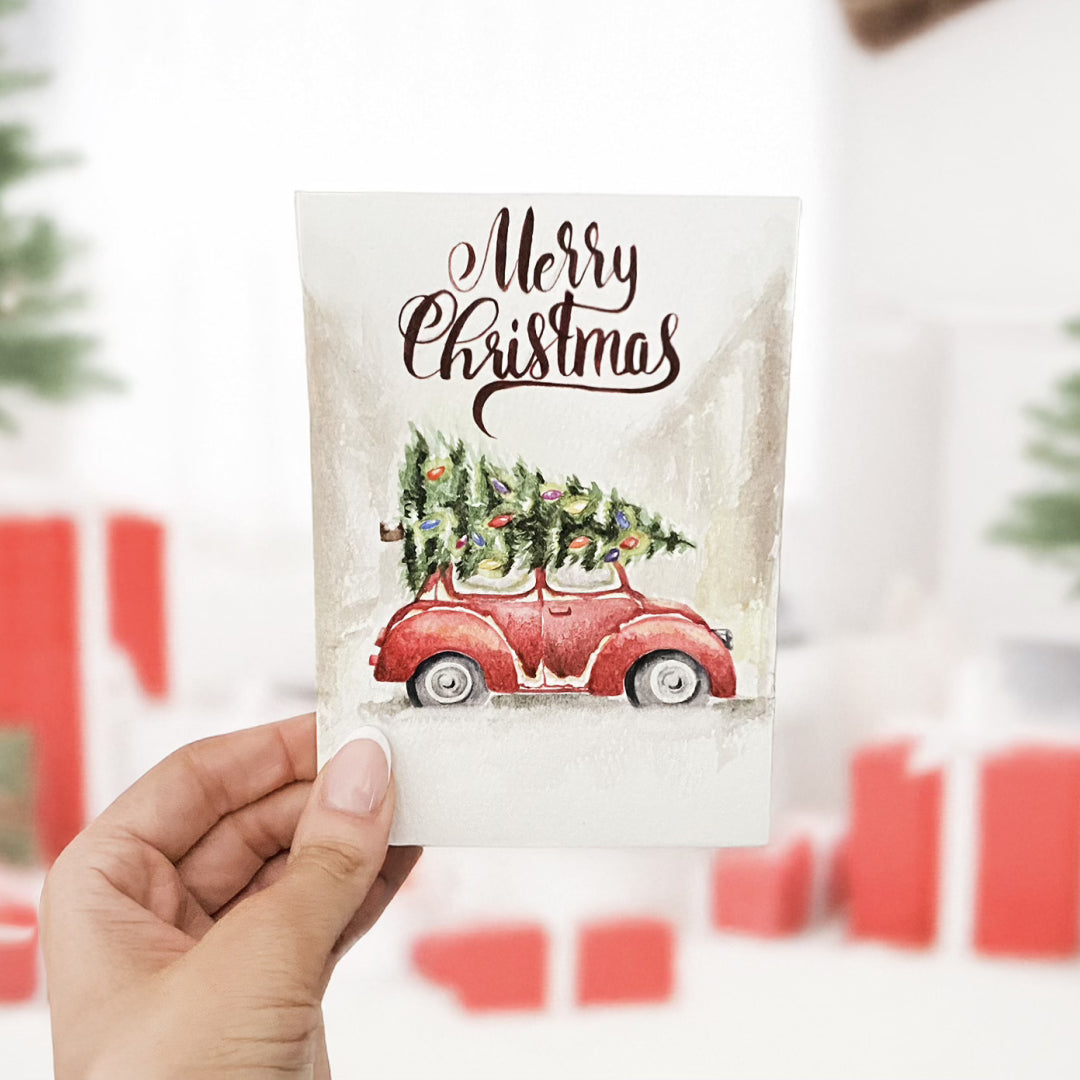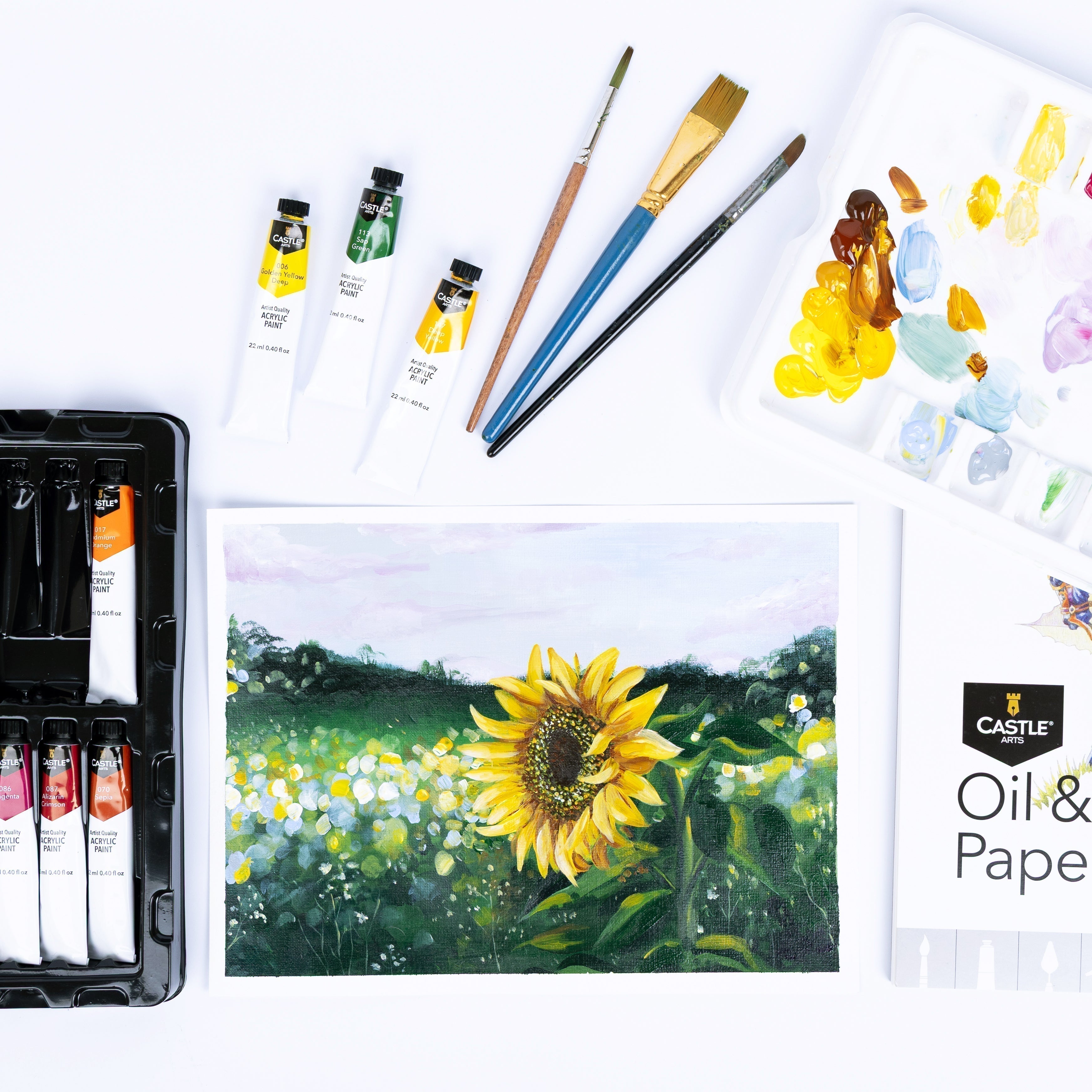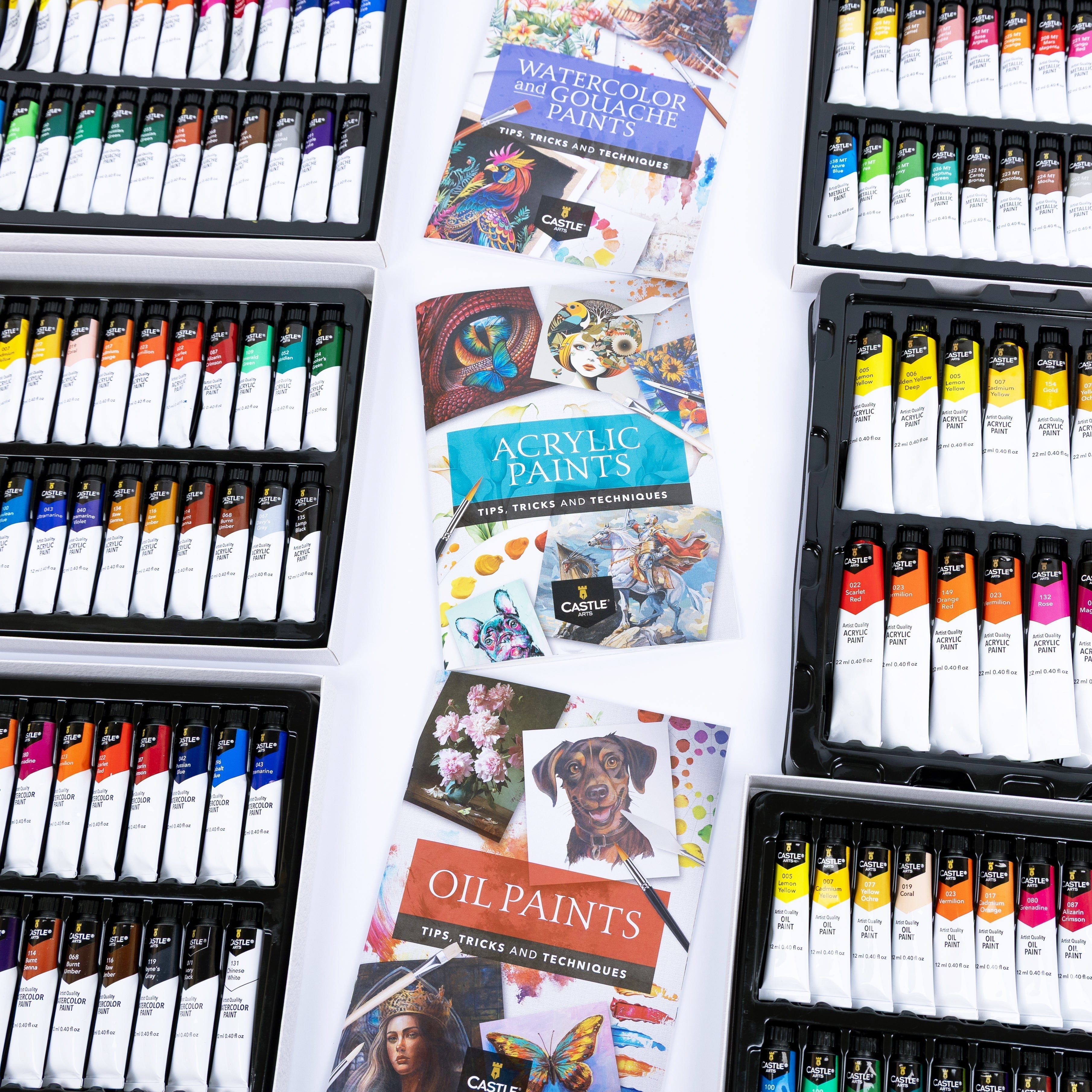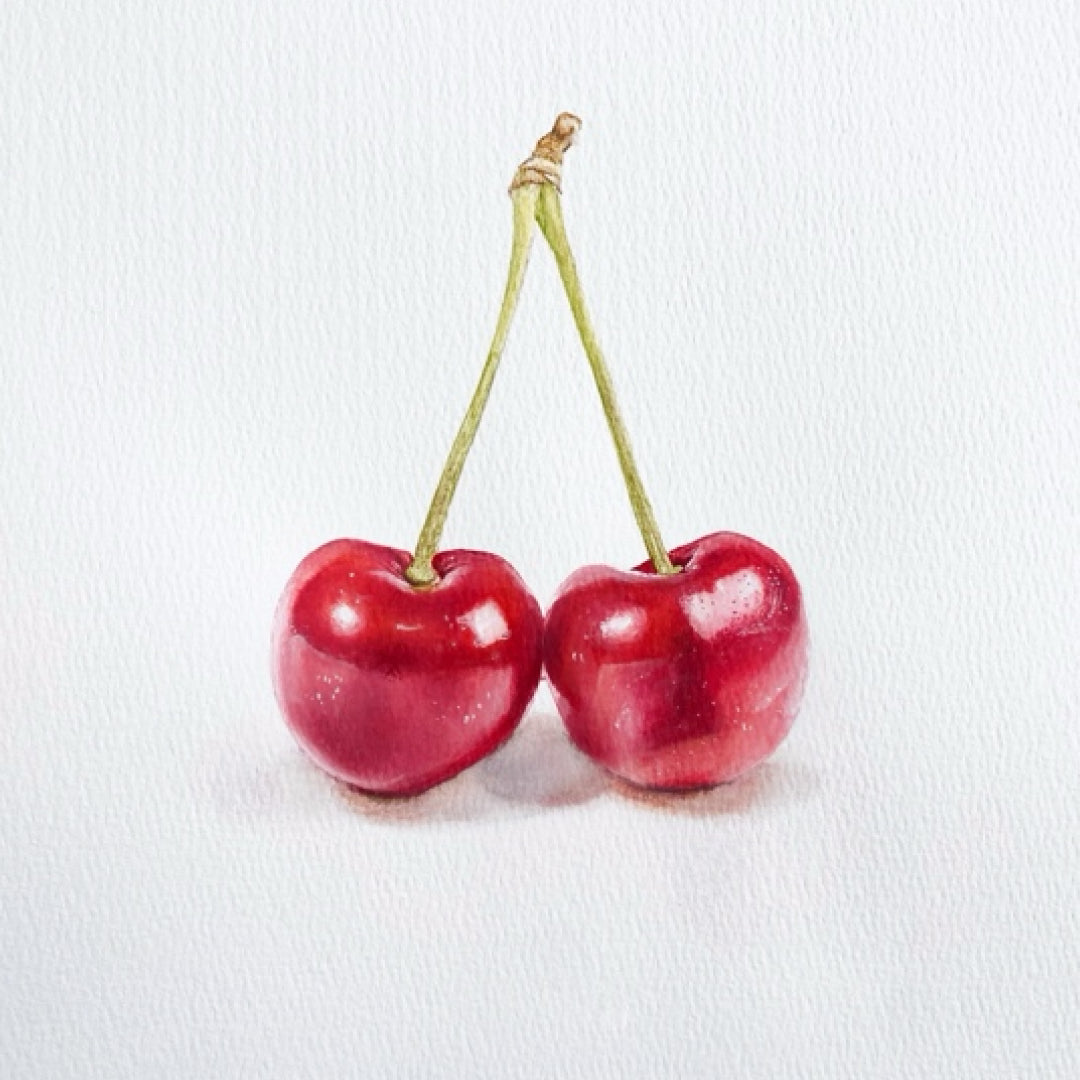
This festive season, try your hand at creating your own DIY watercolour Christmas cards. In this step-by-step tutorial, we provide all the tips you need to create two beautiful designs, each one perfect for creating holiday cards or framing as a heartfelt gift.
Whether you're a total beginner or an experienced artist, you'll have loads of fun creating these easy watercolour Christmas cards at home. Watercolours are a very forgiving medium with strong pigments, making them perfect for artists of all levels.
In this guide, we’ll show you how to paint watercolour Christmas cards with two festive designs: a classic red car carrying a Christmas tree and a colourful reindeer adorned with lights. Let’s get started!

What You’ll Need
To create your own painted Christmas cards, you’ll need the following:
- Watercolour paint set – Castle Arts 24-Piece Watercolour Paint Set
- Brushes
- Watercolour paper – Castle Arts Watercolour Sketch Pads
- Palette or plate for mixing
- Cup of water (e.g., old jar)
- Kitchen paper
- Pencil for sketching
- Optional: Template for tracing or copying (see below)
Design 1: How to Paint a Christmas Car Watercolour Card
 This stunning Christmas card captures a nostalgic scene, with a classic red car carrying a brightly lit Christmas tree. To create this design, you'll use lots of warm tones and top the card with a festive greeting.
This stunning Christmas card captures a nostalgic scene, with a classic red car carrying a brightly lit Christmas tree. To create this design, you'll use lots of warm tones and top the card with a festive greeting.
Step 1

Gather your supplies then start by folding your piece of watercolour paper in half to create your card. Start sketching a rough outline of your design. Press lightly and don’t worry about adding too much detail, you just want an idea of the composition. Any dark pencil marks may show through the paint.
Step 2

Pick a section to start painting. You can choose any colours you like, but if you want to create the red of the car pictured, wet your brush thoroughly and on your palette mix a ‘puddle’ of the colours Alizarin Crimson and Scarlet Red. Fill in the area using gentle strokes.
You can add shadows by dipping your brush into a darker complementary colour and tapping it onto the already wet area. This is called the wet-on-wet technique. You’ll see the colour disperse into the existing colour.
Step 3

Head over to the other side of your painting and repeat the previous step.
Tip: start on one side then switch so each area has some time to dry. This will prevent bleeding.
Step 4

Give the first area some time to dry before moving on to the next part of the car. As you paint, remember to leave any areas you want to keep white, such as snow, untouched. With this in mind, continue painting the car, leaving small snow mounds on the wheel arches for added detail.
Step 5

Once the car is fully painted, move on to the wheels. Mix Chinese White and Ivory Black to create a grey shade. Use this same mix to add shading to the windows, leaving a white edge to make the car look cosy.
Tip: Unless you're intentionally creating grey, avoid using black in your paintings, especially for shadows. Black can make the painting appear flat once dry. Instead, try deepening the hue with other dark complementary colours.
Step 6

The tree is next! Start by adding colourful lights—you can also include extra decorations like presents, tinsel, or baubles for a unique look. For the lights, choose bright, festive colours and fill in some small oval shapes on the tree, arranging them in a zig-zag pattern.
Step 7

For the tree branches, mix Hookers Green, Emerald Green, and Chinese White. Dilute your paint so it's quite transparent. Again, leave some white patches to mimic snow resting on the tree.
Use the shape of the brush to your advantage, applying small, deliberate strokes to imitate the texture of the branches. Build up the opacity of your greens by adding more paint and layer up the branches.
Step 8

Wait for the green to dry completely. Then, to make your lights sparkle, mix Lemon Yellow and Cadmium Yellow and water down your paint. Use this mix to outline each light with a soft yellow glow, creating a warm ambience.
Edge any ‘white’ snowy areas you have left clear of paint with a light layer of yellow to reflect the glow of your festive tree.
Step 9

For the background, using perspective, draw two angled lines on either side of the car so it looks like a cross through the page. Use a very diluted mix of Burnt Umber and Paynes Gray to fill in these spaces.
To add depth and mimic the appearance of buildings, use a slightly deeper version of the same colour mix to paint vertical lines toward the outer edges of your page.
Tip: To create a sense of distance, use lighter colours for areas further back in your painting and stronger, more saturated colours for areas closer to the foreground.
Step 10

Lastly, we’ll add some detail below the car. To start, rip off a piece of kitchen roll and roll it into a point. Dip the nib into the water and rub the bottom part of the wheel off to make the car look like it's driving through snow.
Step 11

To create the shadow under the car, use the same brown/grey mix we used for the background and add a horizontal line underneath the car. Clean and wet your brush and spread that paint down the page.
Step 12

To finish your card, write ‘Merry Christmas’ at the top in the lettering of your choice! You can use paint or a fineliner pen to do this.
Christmas Car Card Template

Design 2: How to Paint a Reindeer Watercolour Christmas Card

This cheerful reindeer design is complete with colourful Christmas lights and is sure to put a smile on any recipient's face. Create it for yourself by following this simple step-by-step tutorial.
Step 1

Round up your supplies and fold your watercolour paper in half. For this painting, we’ll be working in landscape, so the folded seam will be at the top. Draw a rough outline of your reindeer, being careful not to press too hard as the pencil marks may show through the paint. Alternatively, trace over the template provided.
Feel free to customise the reindeer's antlers with your own decorations—tinsel, baubles, or any other festive details you’d like to include!
Step 2

Step 3

To add dimension to the reindeer’s face, incorporate different tones of brown. Pick up more of the brown shades on your palette and, without diluting them as much, use these to add in some shadows. Allow the 'fur' to dry off to prevent any bleeding.
Once dry, use Burnt Umber straight from the tube for an opaque finish to paint the eyes and nose. Leave a small highlight in the eyes to bring your reindeer to life.
Step 4

If you want your reindeer to be a little fluffier, add some fur detail around the face. Using the tip of your brush, held upright to the paper with some brown paint on, create tiny strokes to mimic the texture of fur. Ensure your brush strokes follow the natural direction of the fur for a more realistic effect.
Step 5

Using the same brown shades that you used for the fur, fill in the antlers. If you've drawn in baubles or other decorations, be mindful to paint around them.
Step 6

To add depth to the antlers, apply a darker shade of brown along one side of each antler. Then, wet your brush and dab off any excess water. Gently run the damp brush along the seam where the two tones meet to blend them together.
Step 7

Now for the most fun part—painting the baubles! You can use any colours and patterns you like.
Again, to add dimension, use a less diluted version of your chosen colour to add some shadows around the edges. Leave a small unpainted highlight in the top right corner of each bauble to create a realistic 3D effect.
Tip: When painting, add a 'light source' so the shadows all align. Sometimes it helps to literally draw a sun on your painting to remind you where the shadows will sit, then rub it out afterwards.
Step 8

For the Christmas lights, feel free to use your favourite colours! To make them appear shiny, leave a small white dot in the upper corner of each light. The pictured painting uses pink (Grenadine mixed with Chinese White). Cadmium Orange, Emerald Green, Cerulean Blue, Violet Lake, and Grenadine.
Step 9

Finally, use Paynes Grey to add the last details. Water down the paint and make sure your brush is at a crisp point to get a thin line. Paint on your strings for the lights and add some bows around the antlers to tie them on. You can also add some hanging string above your baubles to finish off the piece.
Reindeer Card Template

We can't wait to see your beautiful creations! Share your watercolour Christmas cards with us on Instagram by tagging @castleartsofficial and use #castlearts to show off your work.






Share: